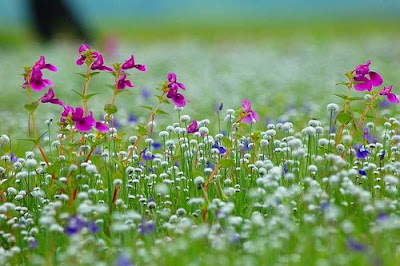By Ms.Katie BagliHi friends,
Last weekend, 23 of us joined Nature
India's trip to Kas, led by Adesh. The Kas plateau, a short distance from Satara, took us by storm, both literally and metaphorically. It was a sight to behold, thousands of flowers of all hues, dancing away in the strong gusts of wind and playing hide and seek amongst the moisture laden clouds that had descended on the scene. Adesh made it a point to show us every flower and Ms.Medha Karkhanis, the knowledgable resource person who had accompanied us, imparting her knowledge with her ever-smiling face and soft, gentle voice. Indeed, the joy of seeing the best of nature put us all on a high.


"Ten thousand saw I at a glance,
Tossing their heads in sprightly dance,
I gazed - and gazed - but little thought
What wealth the show to me had brought."
These words of William Wordsworth resounded in my head.
Even with the sun hidden by the clouds, the carpets of Senecio grahami (Sonki) shone out like little golden bulbs greeting us on the hillside, en route to the plateau.

Here and there stood out the solitary stalks of Lavendula bipinnatas. The purple Hill Karvis - Carvia callosa - with their blushing pink buds, embraced the hill slopes. Interspersed amongst these along the road were the Tridax procumbens or Coat buttons, there seeds bearing whorls of hairs like dandelions. The spikes of tiny flowers of Indigofera astragalina or Phulzadi and Indigofera cassoides with their cassia-like leaves appeared like little pink sparklers.
Two species of Justicia - procumbens and betonika were amongst the lilliputian flowers trying to prove that small is beautiful. In contrast the much larger flowers of the climbers Abhai or Canavalia gladiata and Vignia Vexillata (Sweet pea) showed off their pink petals that seemed to be folded one inside the other following the art of origami. Their smaller version in yellow were the Vignia radiata or Wild Moong.

Various species of Cyanotis or Cat's ears (in a lighter sense but more appropriately like Lallu Prasad's ears) were spotted: C. cristata, C. fasciculata and C. tuberosa.
The American Softhead or Lagascea mollis intrigued us with its spherical inflorescence. The Nightshade family of Solanums had spines on the veins of their leaves - a peculiar feature. The Undhiphuls or Trichodesma indicum or Indian Borage, had upside down flowers their calyx being winged.
The Ranjire or Pimpinella tomentosa carried its tiny specs of white flowers on umbels having reddish stalks. The pale pink flowers with a red spot - Sopubia delphenifolia or Dudhali, were found growing along the grasses, as it is a root parasite on them.

What took our breath away were the fields of Topli Karvis (Pleocaulus ritchei) that indeed posed a spectcle - baskets of purple flowers swaying in the breeze.

We even saw at one point a patch of white Karvis. Not to be outdone, were fields of the yellow Smithias, both sensitiva and bigemina with their two red spots, making them appear like Mickey Mouses.
In the pools of water growing gregariously were the Bearded Marsh Stars or Pogostemon deccanensis (Jambhali-manjiri). The nutrient deficient soil of the plateau induced the growth of intriguing insectivorous plants like the Seetachi-aswe or Utricularia purpurascens found in the company of Gend (Eriocaulon sedgewickii).


Similarly, the presence of the royal purple Exacum indicated that we would find here its companion the Sundew or Drossera indica. Adesh even showed us the tiny insects that had got trapped on its sticky dew-like secretions.

Another interesting insectivorous plant was the Devil's Claws or Martynia annua, whose petals and leaves felt very soft and adhesive like, a sure trap for insects. Amongst the ground orchids were the Habeneria heyneana or Kangwa since it looked like a comb, H.crassifolia and H.digitata with its greenish-yellow flowers.
The fields of Balsams were impatiently awaiting our admiring glances - Impatiens balsamina, I. oppositifolia which had tiny leaves and no spurs, I.rosmarinifolia, I.lawi and the bright yellow I.dalzelli. We got the thrill of watching the seeds flying out impatiently from its capsules, when applying a slight pressure; thus the generic name.
The only peach coloured flower was that of Murdania lanuginosa or Abolima, its beauty accentuated by a sheen of gold dust on its petals.

On the last day we were lucky to sight the highly endangered Gloriosa superba or Kad lavi - known to induce labour pains. After getting pollinated, the red twirling petals of the corolla turn yellow. The apex of its leaves are modified into tendrils for twining around the support. Bunches of violet and white stars stood out against the dark rocks - the Taragucha or Neonatis lancifolia.
Also found on the moss-covered rocks were the Begonia crennata, the male and female flowers being separate. The leaves are edible, so we tasted them.

There were many more such jewels. The list seems to be endless - our sightings in two days having totalled to 104. The above descriptions are intended just to give an idea of the diversity and richness of this plateau.
Very fortunately for this plateau of flowers, there are several factors that have contributed towards its remaining in its pristine form.
The laterite soil cover is minimal, just a few inches, and as mentioned before, depleted of nutrients. Thus trees and other bigger plants do not grow here and the herbs and shrubs do not face any competition for sun and air. Since not much grass grows, there is no grazing. Several insectivorous plants grow here to make up for the lack of richness of the soil. This area is not so well known to picnickers.
Let us hope such beautiful spots showing the best of nature remain untouched in their entirety for the future generations.
Cheers,

















































